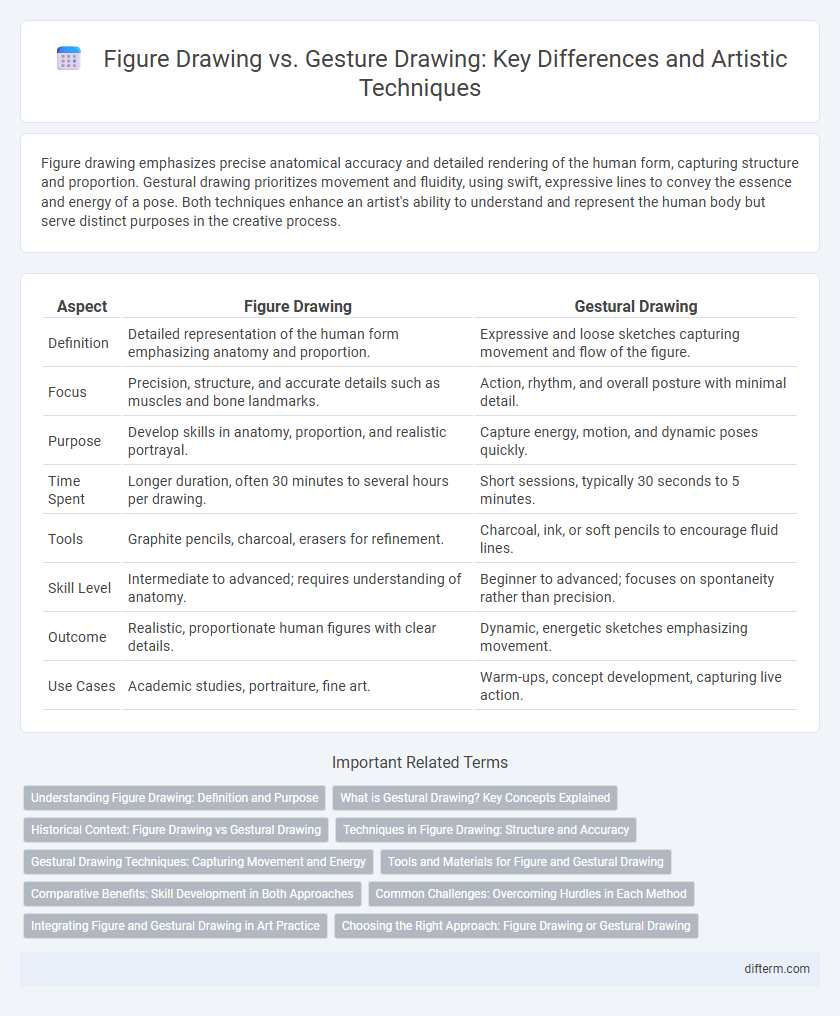Figure drawing emphasizes precise anatomical accuracy and detailed rendering of the human form, capturing structure and proportion. Gestural drawing prioritizes movement and fluidity, using swift, expressive lines to convey the essence and energy of a pose. Both techniques enhance an artist's ability to understand and represent the human body but serve distinct purposes in the creative process.
Table of Comparison
| Aspect | Figure Drawing | Gestural Drawing |
|---|---|---|
| Definition | Detailed representation of the human form emphasizing anatomy and proportion. | Expressive and loose sketches capturing movement and flow of the figure. |
| Focus | Precision, structure, and accurate details such as muscles and bone landmarks. | Action, rhythm, and overall posture with minimal detail. |
| Purpose | Develop skills in anatomy, proportion, and realistic portrayal. | Capture energy, motion, and dynamic poses quickly. |
| Time Spent | Longer duration, often 30 minutes to several hours per drawing. | Short sessions, typically 30 seconds to 5 minutes. |
| Tools | Graphite pencils, charcoal, erasers for refinement. | Charcoal, ink, or soft pencils to encourage fluid lines. |
| Skill Level | Intermediate to advanced; requires understanding of anatomy. | Beginner to advanced; focuses on spontaneity rather than precision. |
| Outcome | Realistic, proportionate human figures with clear details. | Dynamic, energetic sketches emphasizing movement. |
| Use Cases | Academic studies, portraiture, fine art. | Warm-ups, concept development, capturing live action. |
Understanding Figure Drawing: Definition and Purpose
Figure drawing is the practice of creating detailed and accurate representations of the human form, focusing on anatomy, proportion, and structure. It serves as a foundational skill for artists aiming to capture realistic poses and muscle definition with precision. The primary purpose of figure drawing is to develop a deep understanding of the body's shape and movement to produce lifelike and anatomically correct artwork.
What is Gestural Drawing? Key Concepts Explained
Gestural drawing captures the essence and movement of a subject through rapid, fluid strokes, emphasizing action over detail. This technique prioritizes the overall form and dynamic motion, allowing artists to convey energy and emotion in a loose, expressive manner. Commonly used as a foundational exercise, gestural drawing enhances observation skills and informs more detailed figure drawing by focusing on posture, rhythm, and proportion.
Historical Context: Figure Drawing vs Gestural Drawing
Figure drawing has its roots in Renaissance art, emphasizing anatomical precision and proportion to capture the human form accurately. Gestural drawing emerged in the early 20th century, influenced by Expressionism and Modernism, prioritizing movement, emotion, and spontaneity over detailed realism. The historical evolution reflects a shift from structured academic study to more expressive, dynamic exploration of the human figure.
Techniques in Figure Drawing: Structure and Accuracy
Techniques in figure drawing emphasize structural accuracy and precise anatomical representation, requiring careful observation of proportions, muscle groups, and skeletal landmarks. Artists utilize contour lines, shading, and perspective to build a realistic form, focusing on static poses and detailed refinement. This contrasts with gestural drawing, where fluidity and movement take precedence over meticulous detail.
Gestural Drawing Techniques: Capturing Movement and Energy
Gestural drawing techniques emphasize quick, expressive strokes that capture the essence of movement and the dynamic energy of the subject rather than precise anatomical details. Artists use fluid lines and varying pressure to convey motion, rhythm, and emotional intensity, often working within short time frames to maintain spontaneity. This approach enhances the depiction of human figures in action, making it a fundamental practice for studying body language and posture in art.
Tools and Materials for Figure and Gestural Drawing
Figure drawing primarily utilizes graphite pencils, charcoal sticks, and conte crayons on smooth textured paper to capture precise anatomical details and form. Gestural drawing often employs vine charcoal, soft graphite pencils, or ink brushes on large, textured paper or newsprint to emphasize swift, expressive movement and fluidity. Both practices benefit from kneaded erasers and blending stumps to refine contours and shading, but their specific tool choices reflect differing artistic intentions and techniques.
Comparative Benefits: Skill Development in Both Approaches
Figure drawing enhances anatomical accuracy, proportion, and detailed rendering skills by focusing on the human form's structure. Gestural drawing cultivates dynamic movement, fluidity, and expressive line quality, emphasizing capturing the essence of a pose quickly. Combining both approaches develops comprehensive artistic abilities, balancing precision with expressive spontaneity.
Common Challenges: Overcoming Hurdles in Each Method
Figure drawing often challenges artists with capturing precise anatomical details and proportions, requiring patience and a strong understanding of human anatomy. Gestural drawing tests an artist's ability to quickly convey movement and energy, demanding fluidity and spontaneity that can be difficult to master. Overcoming hurdles in both methods involves consistent practice, focused observation, and balancing accuracy with expressiveness to enhance overall drawing skills.
Integrating Figure and Gestural Drawing in Art Practice
Integrating figure drawing and gestural drawing enhances artistic expression by combining accurate anatomical representation with dynamic movement and flow. Mastery of figure drawing provides structural foundation, while gestural drawing captures energy and emotion, resulting in more lifelike and compelling compositions. Consistent practice blending both techniques fosters improved observational skills and a deeper understanding of human form and motion in art.
Choosing the Right Approach: Figure Drawing or Gestural Drawing
Figure drawing emphasizes precise anatomy and proportion, making it essential for artists seeking detailed and accurate human representations. Gestural drawing captures movement and emotion swiftly, ideal for developing expressive skills and fluidity in sketches. Selecting between figure drawing and gestural drawing depends on whether the artist prioritizes structural accuracy or dynamic energy in their work.
Figure Drawing vs Gestural Drawing Infographic

 difterm.com
difterm.com